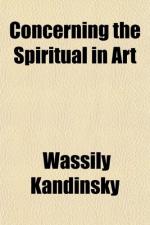The two shades of red just discussed are similar to yellow, except that they reach out less to the spectator. The glow of red is within itself. For this reason it is a colour more beloved than yellow, being frequently used in primitive and traditional decoration, and also in peasant costumes, because in the open air the harmony of red and green is very beautiful. Taken by itself this red is material, and, like yellow, has no very deep appeal. Only when combined with something nobler does it acquire this deep appeal. It is dangerous to seek to deepen red by an admixture of black, for black quenches the glow, or at least reduces it considerably.
But there remains brown, unemotional, disinclined for movement. An intermixture of red is outwardly barely audible, but there rings out a powerful inner harmony. Skillful blending can produce an inner appeal of extraordinary, indescribable beauty. The vermilion now rings like a great trumpet, or thunders like a drum.
Cool red (madder) like any other fundamentally cold colour, can be deepened—especially by an intermixture of azure. The character of the colour changes; the inward glow increases, the active element gradually disappears. But this active element is never so wholly absent as in deep green. There always remains a hint of renewed vigour, somewhere out of sight, waiting for a certain moment to burst forth afresh. In this lies the great difference between a deepened red and a deepened blue, because in red there is always a trace of the material. A parallel in music are the sad, middle tones of a cello. A cold, light red contains a very distinct bodily or material element, but it is always pure, like the fresh beauty of the face of a young girl. The singing notes of a violin express this exactly in music.
Warm red, intensified by a suitable yellow, is orange. This blend brings red almost to the point of spreading out towards the spectator. But the element of red is always sufficiently strong to keep the colour from flippancy. Orange is like a man, convinced of his own powers. Its note is that of the angelus, or of an old violin.
Just as orange is red brought nearer to humanity by yellow, so violet is red withdrawn from humanity by blue. But the red in violet must be cold, for the spiritual need does not allow of a mixture of warm red with cold blue.
Violet is therefore both in the physical and spiritual sense a cooled red. It is consequently rather sad and ailing. It is worn by old women, and in China as a sign of mourning. In music it is an English horn, or the deep notes of wood instruments (e.g. a bassoon).
[Footnote: Among artists one often hears the question, “How are you?” answered gloomily by the words “Feeling very violet.”]
The two last mentioned colours (orange and violet) are the fourth and last pair of antitheses of the primitive colours. They stand to each other in the same relation as the third antitheses—green and red—i.e., as complementary colours (see Fig. 2).




